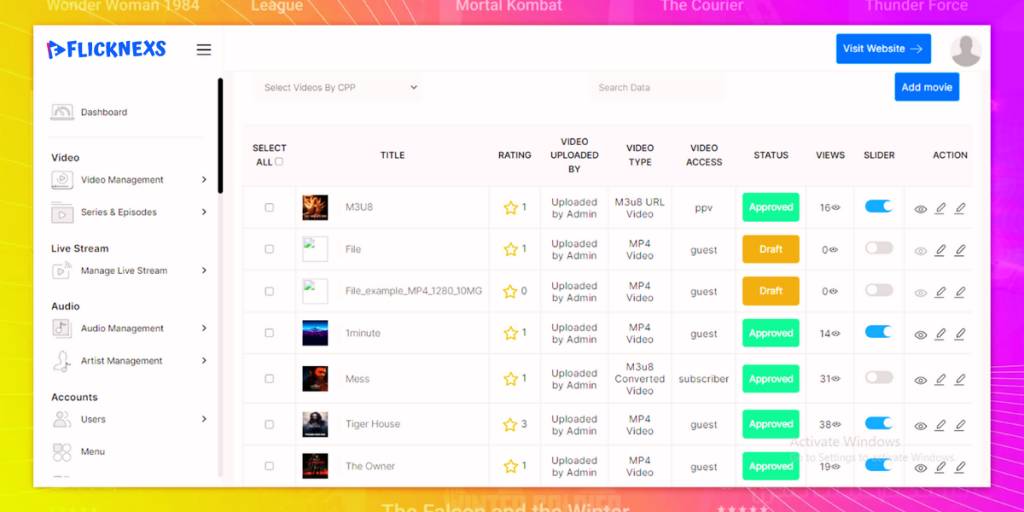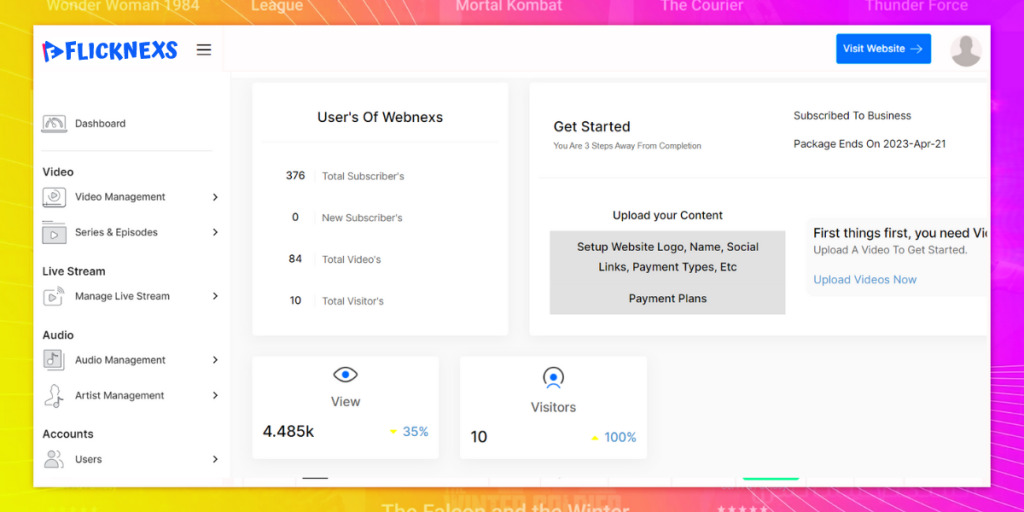Are you considering launching an online TV channel for your business? Explore this comprehensive guide on how to create your own online tv channel.
Advancements in technology have significantly altered the landscape of OTT platforms in recent years. Traditional television networks are facing increasing challenges from media giants like Hulu, Amazon Prime, Netflix, and other online TV channels.
The rapid pace of technological advancements continues to shape the industry, prompting businesses to invest in establishing their own broadcasting stations.
Creating an online TV channel has emerged as the latest trend in the entertainment sector. Cable TV providers are compelled to unbundle their offerings due to fierce competition from various video streaming services.
The way consumers engage with content has been transformed by smart TVs and virtual reality. This is an opportune moment to capitalize on the evolving digital world by launching your own web TV channel.
Benefits of Creating an Online TV Channel
Convenient viewing experience:
Similar to streaming services like Netflix and Amazon, online TV channels can deliver videos at flexible time frames and offer a user-friendly viewing experience.
Reliability:
Researching and ensuring a reliable platform for broadcasting your TV station, including complete ownership of videos and effective monetization strategies, will attract and retain viewers.
Faster results with smart connectivity:
To succeed, a web TV channel must prioritize high-speed internet transmission and HD video streaming capabilities, accessible to a global audience.
Compatibility across devices:
A well-built online TV channel should enable seamless streaming of audio and video content on various devices, including PCs, tablets, smart TVs (like Apple TV, Amazon Fire TV, and Android TV apps), and gaming consoles, ensuring viewer engagement.
Diverse viewing choices:
To keep viewers engaged, it’s essential to curate a wide range of shows, movies, entertaining VODs, and other content, offering a more diverse selection than traditional TV.
Profitability through affordability:
The number of target audiences and the return on investment (ROI) are interconnected. Engaging video content can attract a large viewership and lead to a reliable client base, contributing to profitability.
7 Steps to Create Your Online Tv Channel
Step 1: Planning Your TV Channel
The first step in creating your own online TV channel is to plan and strategize. This involves identifying your target audience, defining your channel’s niche and content, and researching and selecting the right platform for your channel
Identifying your target audience:
Identifying your target audience is crucial when creating your own online TV channel. For example, if you are passionate about fitness and wellness, your target audience may be health-conscious individuals seeking workout routines and nutrition tips. You can create content tailored to their needs, such as live fitness classes, interviews with fitness experts, and healthy cooking segments. By understanding your target audience’s preferences and interests, you can create a compelling online TV channel that resonates with them and establishes a loyal viewership.
Before creating content for your TV channel, it’s crucial to identify your target audience. Who are they? What are their interests? What type of content do they consume? Understanding your audience will help you create content that resonates with them and meets their needs.
Defining your channel’s niche and content:
Once you have identified your target audience, it’s essential to define your channel’s niche and content. Describe the content that your channel will showcase. What topics will you cover? What makes your channel unique and different from others? Defining your niche and content will help you establish your channel’s identity and attract a dedicated audience.
Researching and selecting the right platform for your channel:
There are several platforms available for hosting and streaming online TV channels, such as YouTube, Vimeo, and Twitch, among others. Research and compare the features, audience reach, and monetization options of different platforms to select the one that best aligns with your channel’s goals and requirements.
Step 2: Creating Your Content

Once you have planned your TV channel, the next step is to create compelling content that resonates with your target audience. This involves developing a content strategy, creating a content calendar, producing high-quality videos, and scripting, filming, and editing your content.
Developing a content strategy: A content strategy outlines the type of content you will create, how often you will publish, and the goals you aim to achieve with your content. It’s important to create a content strategy that aligns with your channel’s niche, target audience, and goals. This will help you stay consistent and relevant in your content creation efforts.
Creating a content calendar: A content calendar helps you plan and organize your content in advance. It ensures that you have a consistent publishing schedule and allows you to stay organized and focused. Create a content calendar that includes the topics, keywords, publishing dates, and promotional activities for each piece of content.
Producing high-quality videos: The quality of your videos is crucial to the success of your TV channel. Invest in good quality cameras, microphones, and editing software to ensure that your videos are visually appealing and have clear audio. Pay attention to lighting, sound, and video resolution to create professional-looking videos that captivate your audience.
Scripting, filming, and editing your content: Before filming, create a script for your videos to ensure that your content is well-structured and engaging. When filming, pay attention to framing, angles, and background elements to create visually appealing videos. Once you have filmed your content, it’s time to edit it. Use video editing software to add graphics, music, captions, and other elements to enhance the quality and impact of your videos.
Read this : How To Create Your Own Movie Streaming Website
Step 3: Branding Your TV Channel
Branding plays a significant role in creating a memorable and recognizable online TV channel. It helps you establish a consistent identity and image for your channel, making it stand out among the vast sea of content online. Here are some steps to brand your TV channel effectively:
Creating a compelling channel name and logo:
Here I would like to narrate a story. Branding your TV channel is crucial to establish a unique identity and connect with your target audience. For instance, Sarah, a fitness enthusiast and personal trainer, created her own online TV channel called “FitLifeTV.” She created a compelling channel name and logo that reflected her fitness expertise and values. She designed channel graphics and visuals that were visually appealing and consistent with her brand image. As a result, Sarah’s branding efforts helped her channel stand out in the competitive fitness industry, attract loyal viewers, and establish herself as a credible fitness influencer.
Choose a channel name that is memorable, relevant to your niche, and easy to pronounce and spell. Design a logo that represents the essence of your channel and reflects your brand’s personality. Your channel name and logo should leave a lasting impression on your audience and create brand recognition.
Designing channel graphics and visuals:
Create visually appealing graphics and visuals for your channel, such as channel banners, thumbnails, intros, and outros. These elements should be consistent with your channel’s niche and branding, and they should reflect the overall tone and style of your content. Use professional design tools or hire a graphic designer to create eye-catching visuals that attract viewers.
Establishing a consistent brand identity:
Consistency is key in branding. Ensure that your channel’s branding elements, such as your channel name, logo, graphics, and visuals, are consistent across all your online platforms, including your website, social media, and promotional materials. This consistency creates a cohesive and memorable brand identity for your TV channel.
Step 4: Setting Up Your Online TV Channel
After creating your content and branding your TV channel, it’s time to set up your channel on your chosen platform. This involves registering and setting up an account, uploading and organizing your content, and optimizing your channel for search engines.
Registering and setting up an account on your chosen platform: Follow the registration process of your chosen platform to create an account for your TV channel. Fill in all the necessary information, such as your channel name, description, logo, and social media links. Customize your channel settings to match your branding, and familiarize yourself with the platform’s features and settings.
Uploading and organizing your content: Start uploading your content to your channel, following the guidelines and requirements of your chosen platform. Organize your content into playlists or categories, making it easy for viewers to find and navigate through your content. Use relevant keywords and tags in your video titles, descriptions, and tags to optimize your content for search engines and increase its discoverability.
Optimizing your channel for search engines: SEO (Search Engine Optimization) is important to improve the visibility and search rankings of your TV channel. Use relevant keywords in your channel name, description, and tags. Create a compelling channel trailer that showcases your best content and encourages viewers to subscribe. Use relevant and engaging thumbnails for your videos, and promote your channel on other online platforms to increase its exposure.
Step 5: Promoting Your TV Channel
Promoting your TV channel is crucial to attract viewers and grow your audience. Here are some strategies to effectively promote your TV channel:
Promoting your TV channel is essential to attract viewers and build a community around your content. For example, you can leverage social media platforms like Instagram and Facebook to share teasers and snippets of your content, engage with your audience, and run targeted ad campaigns. Collaborating with influencers or other channels in your niche can also help expand your reach and gain new viewers. Additionally, engaging with your audience through comments, messages, and live Q&A sessions can foster a sense of community and loyalty among your viewers, encouraging them to share and promote your channel to their own networks.
Leveraging social media and other marketing channels:
Utilize social media platforms, such as Facebook, Instagram, Twitter, and LinkedIn, to promote your TV channel. Share your content, engage with your audience, and use relevant hashtags to increase your reach. Collaborate with other content creators or influencers in your niche to expand your audience. Additionally, consider other marketing channels, such as email marketing, content marketing, and paid advertising, to reach more viewers and promote your channel.
Collaborating with influencers or other channels:
Collaborating with influencers or other channels in your niche can be a powerful way to promote your TV channel. Identify influencers or channels that align with your niche and target audience, and reach out to them for potential collaborations. This can include guest appearances on their shows, cross-promotions, or joint projects. Collaborating with influencers or other channels can help you tap into their existing audience and gain more exposure for your TV channel.
Engaging with your audience and building a community:
Building a community around your TV channel is essential for fostering engagement and loyalty among your viewers. Respond to comments on your videos, engage with your audience on social media, and encourage discussions and interactions among your viewers. Create a sense of community by offering exclusive content, hosting live streams or Q&A sessions, and organizing contests or giveaways. Building a strong community around your TV channel can lead to increased viewership, loyalty, and word-of-mouth promotion.
Step 6: Monetizing Your TV Channel
If you’re looking to generate revenue from your online TV channel, there are various monetization options to explore. Here are some strategies to monetize your TV channel:
Exploring different revenue streams: There are several ways to generate revenue from your TV channel, including ads, sponsorships, subscriptions, merchandise sales, and crowdfunding. Research and evaluate the different options that align with your content, niche, and target audience. Experiment with different revenue streams to find the ones that work best for your TV channel.
Setting up monetization options on your platform: Depending on the platform you’re using for your TV channel, there may be built-in monetization options available, such as YouTube’s Partner Program or Twitch’s Affiliate Program. These programs allow you to earn money through ads, subscriptions, and other features. Follow the platform’s guidelines and requirements to set up monetization options for your channel.
Analyzing and optimizing your channel’s performance: Monitoring and analyzing your channel’s performance is crucial to optimizing your monetization strategies. Track your revenue, audience engagement, and other metrics to understand what is working and what needs improvement. Use this data to make informed decisions about your content, promotion, and monetization strategies.
Step 7: Growing Your TV Channel
Growing your TV channel requires continuous effort and improvement. Here are some strategies to grow your TV channel:
Continuously improving your content quality:
Keep refining and improving the quality of your content. Listen to feedback from your audience, and make adjustments accordingly. Stay updated with the latest trends and technologies in your niche, and adapt your content to meet the changing preferences of your audience. Creating high-quality, engaging, and relevant content is crucial to retaining and attracting viewers.
Analyzing data and metrics to make informed decisions:
Regularly analyze the data and metrics of your TV channel, such as views, watch time, audience demographics, and engagement rates. This data provides valuable insights into the performance of your channel and can help you identify areas for improvement. Use this data to make informed decisions about your content, promotion, and monetization strategies.

Expanding your reach and audience:
Continuously work on expanding your reach and audience. Collaborate with other content creators or influencers in your niche, leverage social media, participate in relevant events or communities, and optimize your channel for search engines. Experiment with different strategies to attract new viewers and expand your audience base.
Conclusion
Creating and managing your own online TV channel can be a fulfilling venture in today’s digital landscape. It offers you the opportunity to showcase your unique content, interact with your audience, and potentially generate revenue. By diligently following the steps discussed in this article, including planning your TV channel, creating compelling content, branding your channel, setting up your online presence, promoting your channel, and exploring monetization options, you can set yourself up for success in the online TV space.
“Empower your creativity, engage your audience, and unlock monetization opportunities by creating your own online TV channel.”
Frequently Asked Questions:
1. How do I identify my target audience for my TV channel?
Identifying your target audience is a crucial step in planning your TV channel. Start by researching and understanding the demographics, interests, and preferences of your potential viewers. Use analytics and insights from your niche or industry to determine the characteristics of your ideal audience. This information will help you create content that resonates with your target audience and attracts their attention.
2. How do I develop a content strategy for my TV channel?
Developing a content strategy involves defining the goals, themes, formats, and frequency of your content. Start by identifying the key themes or topics that align with your niche and target audience. Plan the formats and types of content you will produce, such as videos, live streams, interviews, or tutorials. Establish a content calendar to schedule and organize your content production and distribution. A content strategy will help you stay consistent and focused on creating content that resonates with your audience
3. How do I brand my TV channel?
Branding your TV channel involves creating a compelling channel name, logo, graphics, and visuals that represent your unique identity and resonate with your target audience. Choose a channel name that is memorable, relevant, and aligned with your content and niche. Create a logo and graphics that are visually appealing, professional, and reflective of your brand personality. Establish a consistent brand identity across all your channel assets to create a cohesive and recognizable brand.
4. How do I set up my online TV channel?
Setting up your online TV channel involves registering and setting up an account on your chosen platform, such as YouTube, Vimeo, Twitch, or social media platforms. Follow the platform’s guidelines and requirements for setting up a channel, including creating a channel name, uploading channel graphics and visuals, organizing your content, and optimizing your channel for search engines. Each platform may have specific features and settings, so it’s important to familiarize yourself with the platform’s functionalities and options.
5. How do I promote my TV channel?
Promoting your TV channel is essential to attract viewers and grow your audience. Some strategies to promote your TV channel include leveraging social media and other marketing channels, collaborating with influencers or other channels, and engaging with your audience and building a community. Utilize social media platforms, email marketing, search engine optimization (SEO), and other digital marketing techniques to create awareness and drive traffic to your channel. Collaborate with influencers or other content creators in your niche to tap into their audience.



Leave a Reply